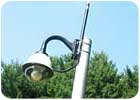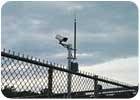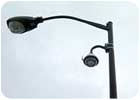VIDEO SURVEILLANCE: IP + DIY = ROI

Outdoor protection — Sony SNC-RZ30N PTZ camera mounts inside Videolarm’s outdoor dome, model SNC-FDP8C2/3Y with integrally built heater blower, and with a Cisco 5.1dBi gain antenna.
Leading edge technology, coupled with a do-it-yourself approach to unique, wireless installation, adds up to solid security return on investment for a “soft target” wastewater facility in the northeast.
New Jersey’s Attorney General got things rolling when, several years ago, he directed major wastewater treatment operations in the state to conduct vulnerability analysis of their facilities.

Risk Assessment
The Rockaway Valley Regional Sewerage Authority (RVRSA), located about 20 miles northwest of New York City, did more than just assess the risk exposure for the unprotected 21-acre site. Instead, the authority’s Executive Director Edward Ho has used the study as a guide to secure the site, including installing a Sony IP-based security system (Sony Security Systems, Park Ridge, N.J.) with nine IPELA network cameras channeling data to a server running Real Shot Manager, Sony’s command and control solution.“Most wastewater facilities resist implementing the recommendations until they are mandated,” Ho said. “We decided to take a proactive approach both for the safety of our employees and for the community.”
The plant processes 12 million gallons of wastewater per day. The site consists of four buildings grouped together, with another building approximately half a mile away. The facility is adjacent to the Boonton Reservoir, primary water supply for Jersey City. There are 27 full-time employees, with the majority on site during the day and a skeleton crew present overnight.
According to the vulnerability analysis, RVRSA was a soft target for terrorists. An attack could pollute nearby water supplies and serve as a diversionary tactic, drawing attention and resources to help facilitate striking other targets in the area.
Key recommendations included installing a security fence around the perimeter as well as an IP-based video surveillance system. The fence went up immediately. Determining the most cost-effective IP system required more research. Initially, Ho invited several security system providers to visit the site and offer proposals.
Most suggested a hardwired design with cameras mounted on the corners of the four main buildings looking outward, with an estimated cost of $130,000 for a turnkey solution.
After reviewing these proposals, Ho and his staff of engineers arrived at a different conclusion. Having a more intimate acquaintance with the facility, they determined that it would be better to establish wireless IP-based cameras at the perimeter looking in. Looking back from the gate would make it more difficult for a camouflaged intruder to conceal his presence.
By going wireless, they would also be able to place a camera at the remote building as well, just beyond the site on the Boonton Reservoir dam located some 5,000 feet from the main office. The do-it-yourself wireless plan was a bold move.
After a month of in-depth research reading manuals and white papers, the authority’s officials believed that their detailed knowledge of the facility combined with the staff’s technical skills could deliver an effective system for about half the estimate proposed by the VARs and integrators.
Cut Cost in Half
“It seemed to us that much of the cost in their packages came from installing a hardwired IP network,” said Ho. Drilling through the concrete buildings would have added considerably to the project. “After a close look, we decided that wireless was the way to go and we had the capabilities for taking this on ourselves. Putting our in-house engineering talent to work on this also offered considerable savings.”One of the great promises of IP-based systems is their relative simplicity of installation, combined with enormous gains in functionality compared to traditional security video. But the authority was hardly sure that installing a full-blown, professional IP surveillance system was really as simple as plugging together other IP networks. Though it was hardly a plug-and-play setup, Ho and his fellow engineers were able to gather the needed components and install them successfully.

Looking inward — Sony SNC-Z20N fixed-focus camera mounted in an Everfocus outdoor housing with heater strip and blower.
Wireless Cards in Cameras
With guidance from Sony, Ho selected seven PTZ cameras with wireless cards plugged into the cameras’ PCMCIA slots. Several mounted on poles that engineers had constructed in their own machine shop, and placed around the perimeter.In addition, a fixed-angle MPEG 4 camera was located in the front lobby, and another fixed angle camera was placed at the front gate encased in a weatherproof housing. A preloaded option on a server computer, Real Shot Manager control software, pulled the pieces together.
The greatest challenge wasn’t the cameras or the server or mastering the software. It was establishing a WiFi network for the video data. Ho selected a Tropos 802.11b 5110 series WiFi cell (Tropos Networks, Sunnyvale, Calif.) for the roof of the control building. To make the network sufficiently robust required a large primary antenna as well as enhanced antennas for each network card installed on the cameras.

Double duty – Another view of a Sony SNC-RZ30N mounted high up in a light pole shows how authority staff used existing infrastructure.
But once the wireless links were established, setting up the rest of the components to monitor images on a 42-inch plasma monitor in the control room, a 32-inch LCD in the manager’s office or a 19-inch auxiliary monitor was easy.
The PTZ cameras patrol the site, focusing on the most vulnerable areas with 16 preset positions. The system was set to monitor for alarm events, allowing real-time response while capturing video data for later analysis.
“Training the staff on Real Shot Manager was simple. Everyone has been impressed with the image quality, stability and color rendition,” said Ho. “It’s quickly become a part of our daily routine without adding any significant effort.”
In the end, what surprised Ho most was how his staff and their families embraced the new security system. Initially, he was concerned that there would be principled objections in the unionized shop to working under surveillance. Much to his surprise, the reaction was quite the opposite.
“The times have changed. We all know we’re vulnerable and want to feel safe at work,” said Ho. “By installing this system, we’ve demonstrated a higher degree of care and loyalty to our staff. It’s also created a new sense of camaraderie and defiance – with this security, no one is going to run us around."
Looking for a reprint of this article?
From high-res PDFs to custom plaques, order your copy today!





